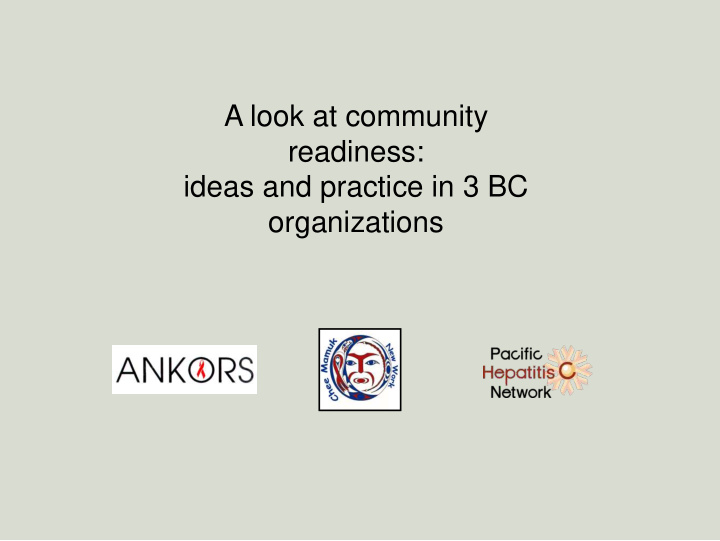



A look at community readiness: ideas and practice in 3 BC organizations �
This presentation will… - Give an overview of the Tri- Ethnic Center’s Community Readiness Model (CRM) - Show how our three distinct organizations in BC use and have modified the CRM - Provide some contact information
Community Readiness Model Overview
Our work with ‘community readiness’ originated with the Tri Ethnic Center for Prevention Education, University of Colorado
What is ‘readiness’ in the Community Readiness Model? Readiness is the degree to which a community is prepared to take action on an issue.
Community Readiness is… • Issue-specific • Measurable • Multi-dimensional Adapted from TriEthnic Center trainers presentation, April 2012
Co Commun mmunity Read ity Readin iness Mode ess Model Provides direction to: Assess readiness Match strategies to level of readiness Evaluate change
CRM Process is: Identify Issue Define “Community” Conduct Key Respondent Interviews Score Interviews to Determine Readiness Level Develop Strategies/Conduct Workshops COMMUNITY CHANGE!
Assess Ass essing ing Ea Each ch of of The These se Ele Elemen ments ts Community efforts Knowledge about the efforts Leadership Community Climate Community Knowledge Resources Each can be at a different level of readiness
2- Den Denial/Resistance ial/Resistance • Continue steps from previous stage • Put up posters and supply brochures • Put information in newsletters
Community Agencies and Interior Health Authority Collaborate on Community Readiness for Harm Reduction: ● 2006/2007IH adopts BBI approach and champions harm reduction ● 2009 ANKORS participates with IH and other agencies towards: 1 - development of a Harm Reduction Position Statement 2 - creation of a Community Readiness Toolkit ● 2009 to 2012 the contracted agencies and Interior Health engage in community readiness needs assessments in communities throughout the IH region.
Cranbrook’s Readiness for Harm Reduction Tested The Community Readiness needs assessment included: identifying and surveying key cross-sector community stakeholders individual interviews scoring using an anchored rating scale for each dimension a community forum on harm reduction focused on: ● release of the Community Readiness results ● community approaches to harm reduction ● action planning
Chee Mamuk Aboriginal Program
Matching strategies to a community’s level of readiness is essential for success.
Community Readiness Simplified the CRM Focused strategies for low levels of readiness Focus on support systems Community Readiness Model: www.triethniccenter.colostate.edu
Mobilizing on HIV/AIDS and STIs in Aboriginal Communities Training held Focus on creating over 4 days change For frontline Community workers assessment Held in a central Creating community location plans
O2I Outreach to Influence a Community Readiness and Effective Prevention of Hepatitis C
O2I Community Readiness and Effective Prevention of Hepatitis C WHY this project and this model? Issues related to effective prevention of hepatitis C are some of the toughest health and social challenges facing our communities. We need effective tools. The process of community change can be complex and challenging – this model breaks the change process into a series of manageable steps.
O2I Community Readiness and Effective Prevention of Hepatitis C 33 month project (July 2011 – March 2014) Funded by the Public Health Agency of Canada (PHAC) 2 CRM Trainings (Vancouver 2012; Prince George March 2014) Connection with TriEthnic Centre staff to support use of CRM during process; problem solving support and sounding board from PHCN staff Evaluation of training, process and results 3 communities carried out CRM assessments, planning and interventions: - Dawson Creek - Abbotsford - Port Alberni
O2I Community Readiness and Effective Prevention of Hepatitis C Some results! Recovery houses actively seeking and providing hepatitis C information and resources for staff and residents Information gaps for key populations identified and addressed ‘Leadership’ in relation to moving forward on unaddressed issues, such as harm reduction, brought to light and addressed
O2I Community Readiness and Effective Prevention of Hepatitis C Flowing from the CRM process in one community: • Health Outreach Team physician started to focus on hep C testing, monitoring and treatment referrals during client visits • MHA nurses took the information from the CRM Project workshop back to their psychiatrists who are now doing hep C follow-up similar to the physician. • MHA and Health Outreach Program nurses learning to support clients on hep C treatment (under the direction of the Liver Clinic – the community is remotely located from the clinic, so this brings that service into the community)
O2I Community Readiness and Effective Prevention of Hepatitis C Challenges using the CRM: -Requires an investment of time, people, materials, supplies and space -New tool and process - requires time, leadership and commitment to learn and integrate into community practice
Thank-you! For more information please contact: Deb Schmitz at deb@pacifichepc.org Sarah Callahan at Sarah.Callahan@bccdc.ca Cheryl Dowden at cheryl@ankors.bc.ca
Recommend
More recommend